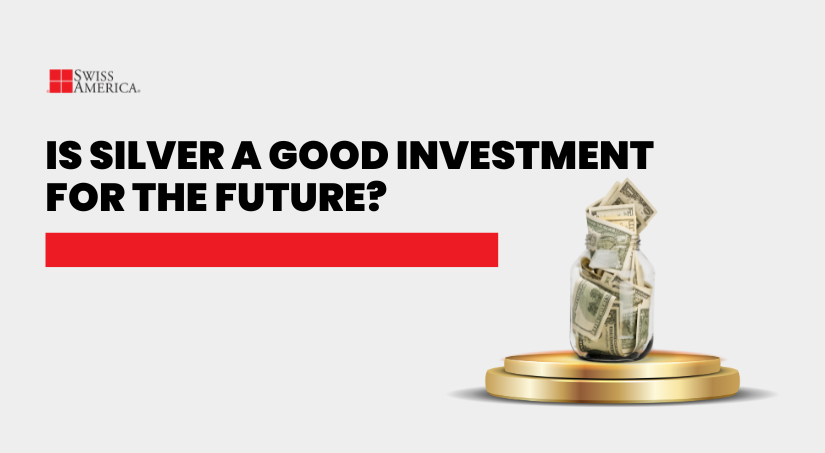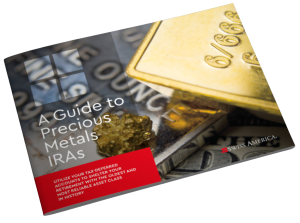
Precious metals make great insurance policies. Investing in gold, silver, or platinum can protect you and reduce risks to your wealth during economic uncertainty. These metals hold their value over time and actually do better when investors worry about the future.
Silver can be an affordable way to own a physical asset that helps protect your wealth. This article covers silver investing to help you decide if it’s the right choice for your portfolio.
Why invest in silver and other precious metals
People buy gold, silver, and platinum as a defense strategy. Investors consider these metals as insurance because they:
Hold value
These assets hold their value over time. The reason is that we only have so much of them on the earth and can’t just make more. When there’s an increase in demand, like for industrial uses or investment purposes, the price goes up. This supply/demand dynamic is why these metals hold their value.
Tangible assets
Physical silver bullion, gold, or platinum are tangible assets. They aren’t like NFTs, crypto, and other digital investments, which can lose value in an instant. And their value doesn’t depend on someone else’s promise or obligation.
Diversify portfolios
Adding metals to your portfolio helps protect you from risk. If a turndown occurs in one investment, you have alternatives to rely on.
Investing in silver bullion vs other metals
If you’re looking at adding metal to your investment portfolio, why would you choose silver over gold or platinum?
Affordable
First, silver is more affordable than gold and other metals. On a per-ounce basis, gold is currently $2720/oz, platinum is $1017/oz, and silver is $32/oz. That’s why silver appeals to investors who don’t have much to invest or those who want to minimize risk. The low price also increases ROI potential.
Say you have $5000 to invest, you can buy:
3 1/2 oz gold coins
Around 140-150 oz silver coins or 14-15 10 oz silver bars
Diversification
Most advisors recommend diversifying your investment portfolio into a mix of assets besides stocks and bonds. Investing in silver can be a great way to achieve this because it moves differently from other financial system assets.
Even when the stock market is in chaos, silver can still perform well. This helps reduce your overall risk and exposure to market-specific events.
Industrial metal
Of course, there are investors in the silver market, but there are also industries that use silver in production for their products. Industrial demand comes from areas like:
Electronics
Solar panels
Medical equipment
Automotive industry
Batteries
Chemical production
Tangible asset
Some people invest in silver bullion coins or bars because they want a tangible asset. You might have concerns about our financial system and what moves the central banks make. Or, you might just want the safety of having an asset that doesn’t rely on digital platforms and faces things like cyber risks.
Limited supply
Physical silver has a limited supply—we can’t simply manufacture more. This means that if you invest in this precious metal and demand increases, silver prices are likely to rise as well. So far, we’ve discovered 1,740,000 metric tons of silver on the earth, which would fit into a cube with sides roughly 55 meters long which is about the length of half a soccer field. It’s not an unlimited resource.
The majority of the world’s silver comes from these four countries:
Mexico
China
Peru
Chile
Potential for growth
The silver market is smaller than gold which means even a small change in demand or supply can have a larger impact on its price. This market volatility can mean dramatic price swings for silver compared to gold. This does mean higher risk, but it also creates greater opportunities for larger upside during periods of market rallies.
Drawbacks of investing in silver
Since we are talking about owning physical silver, there are some drawbacks you should consider:
Bulkiness
Storing silver coins or bars requires more space than gold. For example, you could hold 2 gold bars or 174 silver bars of the same value. With more bars and coins, you’ll need to consider the extra storage space and the added costs if you use a third-party depository to store your physical silver.
Higher premiums
When you purchase silver from coin dealers, you’ll pay above the current market price, known as the “spot price.” The extra amount you pay is called the premium.
As a percentage of the spot price, silver bullion usually has a higher premium than gold, largely due to its lower cost and the fixed costs of production and storage.
Selling considerations
Selling silver can take more time than selling gold. The gold market is larger, so you’re likely to find a buyer more quickly.
Silver’s future outlook
Factors that impact silver investment include:
The economy: Investors who worry about the economy or what might happen with the growing U.S. national debt turn to investments like silver.
Geopolitical events: Sanctions and trade relations or regional wars like Russia-Ukraine and the growing war in the Middle East cause investors to look for safe-haven assets like silver.
Supply/demand: Experts estimate that we have a 17% silver deficit with an increased 2% demand growth, which explains why silver prices keep rising.
While the silver price increase benefits investors, they also mean higher costs for first-time buyers. That’s why you should buy silver sooner rather than later to get in at a lower price point.
We see a bright future for silver and recently discussed our predictions on our podcast:
Ways to invest in silver
There’s a few different ways you can participate in the silver market, including:
Physical Silver
You can buy physical silver coins or silver bars from a reputable dealer. Owning physical silver gives you a completely independent asset that you fully control.
In the Reddit r/Investing forum, user DoU92 shares their reasons for investing in silver:
“I am beginning to allocate a small percentage of my portfolio towards physical silver. Here’s why:
I want to diversify my portfolio beyond cash, stocks and crypto.
The gold/silver ratio is at 90. Meaning 90 ounces of silver buys 1 ounce of gold. Historically the average is around 70. Seems like a good time to buy silver.
Silver is a hedge against the USD and US financial markets. If we head into a recession, silver typically performs well.
Silver is a non-digital asset. I cannot think of a physical asset that stores value better than silver, other than other precious metals or land / real estate. It has gone from $5 an ounce to $22 an ounce since 1975. It is important to me to own physical assets that will appreciate in value.
It is a solid vehicle for transferring wealth to my children in the future.
It’s shiny! Also, it is fun collecting certain coins if you are willing to pay an extra premium.
Value stems from a myriad of industrial and medical uses.
Let me know what you guys think. I know it isn’t the best investment in the world, but it seems sensible to allocate a small percentage of my portfolio to it.”
Exchange Traded Funds (ETFs)
Invest through silver ETFs, which have underlying physical assets like silver bullion, futures contracts, or mining stocks.
Silver Futures
Bullion futures are contracts where you agree to buy or sell silver at a preset price by the contract expiration date. You will not own the silver until the transaction happens- you will only own the contract. You also have the option to sell the contract before you sell the silver.
Stocks
Silver stocks allow you to invest in mining companies. You’ll own shares in companies that can benefit from global silver demand and rising silver prices. However, these investments require silver mining companies to perform so that you can benefit from your investment.
Mutual funds
These paper assets are similar to ETFs in that both allow you to invest directly in silver rather than silver mining stocks. Mutual funds have higher management expense ratios, which could reduce ROI and premiums. However, you can benefit from expert advice.
3 steps for buying silver bullion
It’s easy to buy silver bullion to add to your portfolio. To get started, you’ll:
Step 1: Choose a precious metal dealer
Be sure to find a reputable dealer who has been in business for decades, has established credentials, and great reviews. This helps you avoid being the victim of a scam.
Step 2: Buy physical silver
If you’re buying silver in a retirement account, your dealer can help make sure that you purchase IRA-approved metals. For those buying silver with non-retirement funds, you can buy whatever silver you want. Just be aware that investment-grade bullion coins are not the same as collectible coins.
Step 3: Store your metal
For silver outside of a retirement account, you can store your silver at home, in a bank safety deposit box, or in a depository. If you set up a Silver IRA, your custodian handles secure storage at an IRA-approved depository.
Why investors choose Swiss America
If you are looking at purchasing silver, consider working with the Swiss America team. Here’s why thousands of investors choose Swiss America:
40+ years in business: Since the early 1980s, we’ve successfully guided investors through numerous economic cycles and market shifts. Our decades of experience make us a seasoned, trustworthy partner in the precious metals landscape.
Happy customers: Our large base of satisfied clients enjoy timely delivery of high-quality metals, responsive and knowledgeable customer service, and consistent performance that meets or exceeds expectations.
Expert advice: We offer expert guidance on secure storage, precious metals IRAs, gold-to-silver ratios, portfolio integration, and market trends. Our team provides the knowledge you need to make smart investment decisions in precious metals.
Fair and transparent pricing: We offer competitive rates and clear pricing, so you always know exactly what you’re paying for your precious metals investment.
Gold trade program: Our gold trade program lets you sell your gold back to us when needed, providing liquidity for emergencies or portfolio rebalancing. We’re committed to your long-term success, not just one-time sales.
Client portal: Leverage our client portal to see the real-time market status of your investments, see trade-in values, and get real-time recommendations.

Investing in silver final thoughts
Silver is a great investment. It’s affordable and popular in growing industries. Like other precious metals, it’s a safe haven asset and provides a hedge against inflation. It’s also versatile, tangible, and a great way to diversify your portfolio.
If you want to learn more about how to invest in silver, contact the Swiss America team today!
FAQs
What will silver be worth in 10 years?
It’s impossible to tell what silver will be worth in 10 years. However, due to supply and demand, some experts predict it may be worth as much as $70 or $80 per oz.
How much silver should I own?
Experts usually recommend allocating 5-10% of your portfolio to precious metals.
Is silver a better investment than gold?
Both can be good investments. Silver costs less, so if you have a lower amount to invest, you might start with silver. Gold has a more consistent demand and is less volatile than silver.
Note: The information in this post is for informational purposes only and should not be considered tax or legal advice. Please consult with your own tax professionals before making any decisions or taking action based on this information.
